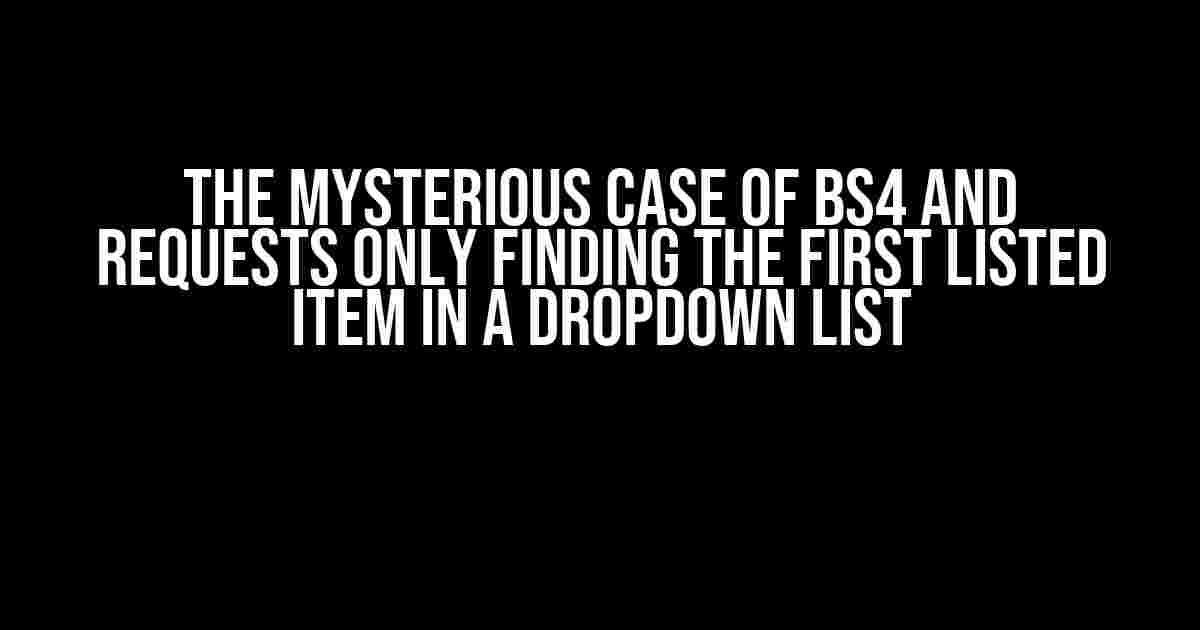Have you ever encountered a situation where your web scraping script, utilizing the powerful combination of BeautifulSoup 4 (BS4) and the requests library, only manages to extract the first item from a dropdown list? If so, you’re not alone! In this article, we’ll delve into the reasons behind this phenomenon and explore solutions to overcome this hurdle.
Understanding the Problem
Before we dive into the solutions, it’s essential to understand why BS4 and requests are only finding the first listed item in the dropdown list. The primary reason for this behavior is that the dropdown list is dynamically generated using JavaScript, which is executed on the client-side.
BS4 and requests, being server-side libraries, do not execute JavaScript by default. As a result, the HTML delivered to your script only contains the initial state of the page, which usually includes the first item in the dropdown list. The remaining items are loaded dynamically when the user interacts with the dropdown, making them invisible to your script.
Solutions to Overcome the Limitation
Now that we understand the underlying issue, let’s explore the solutions to overcome this limitation:
Selenium WebDriver
from bs4 import BeautifulSoup
from selenium import webdriver
# Initialize Selenium WebDriver
driver = webdriver.Chrome() # Replace with your preferred browser
# Load the webpage
driver.get("https://example.com/dropdown-list")
# Get the HTML content
html = driver.page_source
# Parse the HTML using BS4
soup = BeautifulSoup(html, "html.parser")
# Find the dropdown list
dropdown_list = soup.find("select", {"id": "my-dropdown"})
# Extract the options
options = [option.text for option in dropdown_list.find_all("option")]
# Print the extracted options
print(options)
# Close the Selenium WebDriver
driver.quit()Requests-HTML Library
from bs4 import BeautifulSoup
import requests_html
# Load the webpage using requests-HTML
r = requests_html.HTMLSession().get("https://example.com/dropdown-list")
# Render the HTML to execute JavaScript
r.html.render()
# Parse the HTML using BS4
soup = BeautifulSoup(r.html.html, "html.parser")
# Find the dropdown list
dropdown_list = soup.find("select", {"id": "my-dropdown"})
# Extract the options
options = [option.text for option in dropdown_list.find_all("option")]
# Print the extracted options
print(options)PyQuery Library
If you’re familiar with jQuery, you might enjoy using the PyQuery library, which provides a similar syntax. Here’s an example of how you can modify your script to use PyQuery:from pyquery import PyQuery
# Load the webpage using PyQuery
doc = PyQuery(url="https://example.com/dropdown-list")
# Find the dropdown list
dropdown_list = doc("select#my-dropdown")
# Extract the options
options = [option.text() for option in dropdown_list.find("option")]
# Print the extracted options
print(options)Best Practices for Web Scraping
- Respect website terms of service**: Make sure you’re not violating the website’s terms of service by scraping their content.
- Use a user agent**: Identify yourself by using a user agent in your requests to avoid being flagged as a bot.
- Handle anti-scraping measures**: Be prepared to handle anti-scraping measures such as CAPTCHAs or rate limiting.
- Store data responsibly**: Store the scraped data responsibly and make sure you’re not infringing on anyone’s copyright.
- Rotate user agents and IP addresses**: Rotate your user agents and IP addresses to avoid getting blocked by websites.
Conclusion
| Solution | Description |
|---|---|
| Selenium WebDriver | Executes JavaScript and loads dynamic content. |
| Requests-HTML Library | Provides a simpler way to parse HTML and execute JavaScript. |
| PyQuery Library | Provides a jQuery-like syntax for parsing HTML and executing JavaScript. |
Frequently Asked Question
Why do BS4 and requests only find and scrape the first listed item in the dropdown list?
This is because BS4 and requests are designed to handle static HTML content. Dropdown lists are dynamic and generated by JavaScript, which these libraries can’t execute. As a result, they only see the first item in the list.
How can I get BS4 and requests to scrape all items in the dropdown list?
You’ll need to use a more advanced tool like Selenium, which can execute JavaScript and interact with dynamic content. This will allow you to scrape all items in the dropdown list.
Is there a way to scrape dropdown lists without using Selenium?
In some cases, yes! If the dropdown list is populated from a separate API or endpoint, you might be able to scrape the data directly from that source. This requires some detective work to identify the API endpoint, but it can be a more efficient solution.
Can I use BS4 and requests to scrape dropdown lists that don’t use JavaScript?
If the dropdown list is populated statically in the HTML, then yes, BS4 and requests can handle it. Just make sure to inspect the HTML structure and adjust your scraping code accordingly.
What are some common mistakes people make when scraping dropdown lists with BS4 and requests?
Common mistakes include not accounting for JavaScript-generated content, not handling pagination or lazy loading, and not inspecting the HTML structure carefully. Make sure to be mindful of these potential pitfalls to ensure successful scraping!
